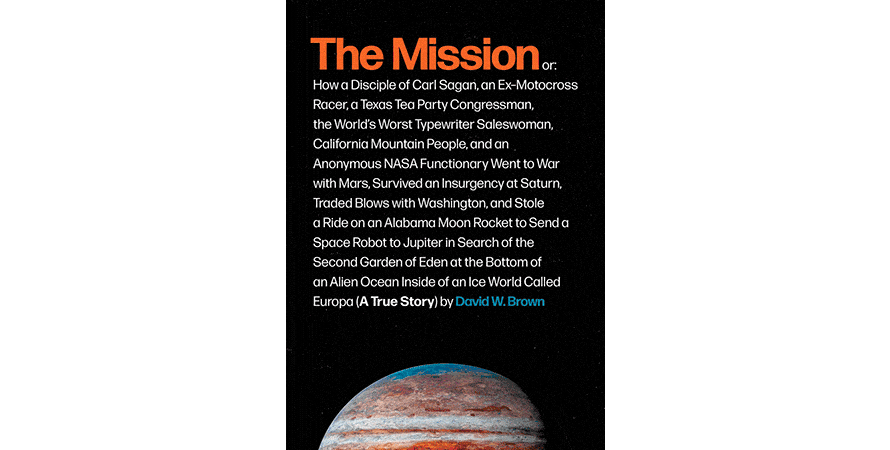Category: Nonfiction
Reviewed by: Peter Spasov
Title: The Mission: A True Story
Author: David W. Brown
NSS Amazon link for this book
Format: Hardcover/Paperback/Kindle
Pages: 480
Publisher: Custom House
Date: January 2021
Retail price: $35.00/$18.99/$14.99
ISBN: 978-0062654427
Brown’s The Mission chronicles years of near-byzantine maneuvers to accomplish a space mission—except that the Europa Clipper has yet to launch.
When Galileo discovered Jupiter’s moon Europa in 1610, nobody knew it would become a contender for hosting extraterrestrial life. Only after flyby observations by the Voyager probes revealed an ice-encrusted world, did analysts conclude the moon sported a liquid ocean under a layer of ice maybe thirty kilometers thick.
Due to the possibility of Europa harboring life, many pitched for further probes to explore this moon. However, compared to other robotic explorations of the outer solar system, a Europa odyssey presents significant hurdles. The biggest is Jupiter’s belt of ions imposing a severe radiation-hardening requirement upon spacecraft electronics. It is difficult to justify a mission when instrument life expectancy is under a hundred days.
Then there is Europa’s extremely thick ice shield, making exploration of the ocean underneath nearly impossible. Many suggested exploring Saturn’s Enceladus instead, also an ice-covered moon but one with jet plumes blasting beyond the surface where said plumes could be sampled by a probe in flight. Only years later would similar plumes be discovered on Europa, thus clinching an eventual go-ahead for a mission to Jupiter’s oceanic moon.
Brown’s book chronicles the lives and careers of women and men bringing the Europa Clipper to life. A cast of scientists, engineers, administrators and politicians endured years of planning and cancellations until final government approval for a more economical mission concept. Included is a segment about NSS and one of its directors.
This story is packed with the pragmatic practice of planetary science, as well as highlighting the engineering tradeoffs for spacecraft design. Some sections highlight daunting technical problems occurring during various outer solar system missions. For instance, launch delays caused lubricants for a high-gain antenna to dry out, thus resulting in overly sluggish data communications for the Galileo robotic space probe. As well, the rivalry amongst branches of the various organizations is revealing. In particular, many stakeholders expressed frustration with the budgetary emphasis given to Mars missions.
Readers will witness what being involved with mission planning is like. There are the tradeoffs concerning instrumentation, spacecraft requirements, costs, mission profiles, and so on. Yet, at times, the narrative occasionally veers off when the connection to the overall story is not immediately apparent. For instance, a rant about a Texas toll road project is several pages long. Presumably, the lesson is about how a politician became the champion necessary for green-lighting a space mission while others are rejected. Indeed many experience the frustrations of planning, revising, compromising and then eventual rejection of a mission. At times, the rivalry between different mission teams seems combative as each tries to win the coveted final budget approval. At least one leader felt that worthy projects “fell victim to the wastefulness of other people.” In particular, the competition between further explorations of Saturn’s Titan, with its methane oceans, and Jupiter’s Europa was especially intense. In fact, competitors named their formal presentations to pitch their missions as shootouts.
During this era of post-Apollo space exploration, NASA similarly struggled to justify its existence by considering flagship missions, missions with multiple components such as orbiter and surface rover, all of which are risky to design, particularly when the surface of the world to explore is still much unknown. Soon the focus remained with Mars exploration. Other teams, as the author terms it, “were eating Ramen to pay its bills.”
Eventually planners standardized mission profiles into phases of flyby, orbit, landing, rover, and sample and return. Even for Mars, the latter remains a “to-do.” All missions have a design and test process, whereby one must balance science payload goals against spacecraft operational necessities. Meanwhile the book interleaves numerous biographical details of personnel involved.
Then the Clipper mission became highly unusual when political influence inserted a clause making it illegal for NASA not to fly a Europa mission.
David W. Brown is a freelance writer who has written articles for numerous publications, mostly concerning the American space program. His style is often creative with witticisms sprinkled throughout out, and occasionally packed with the more poetic. The author occasionally jokes; for instance one planetary scientist was selling three-ring binders early during her career, which Brown described as “exciting.” He refers to “bare-fisted science” in one section, and “bare-knuckle engineering” in another. It is his playful wordplay that adds joy to the reading experience.
In summary, The Mission is an extensively researched work with photographs, notes and index, but also is creatively written with segments of near novel-like narration and dialogue. Brown’s non-fiction concludes with a descriptive narration of one of the scientists also exploring the floor of the Pacific Ocean, an appropriate way to conclude an epic about exploring an extraterrestrial ice-covered oceanic world.
© 2021 Peter Spasov
Please use the NSS Amazon Link for all your book and other purchases. It helps NSS and does not cost you a cent! Bookmark this link for ALL your Amazon shopping!



















